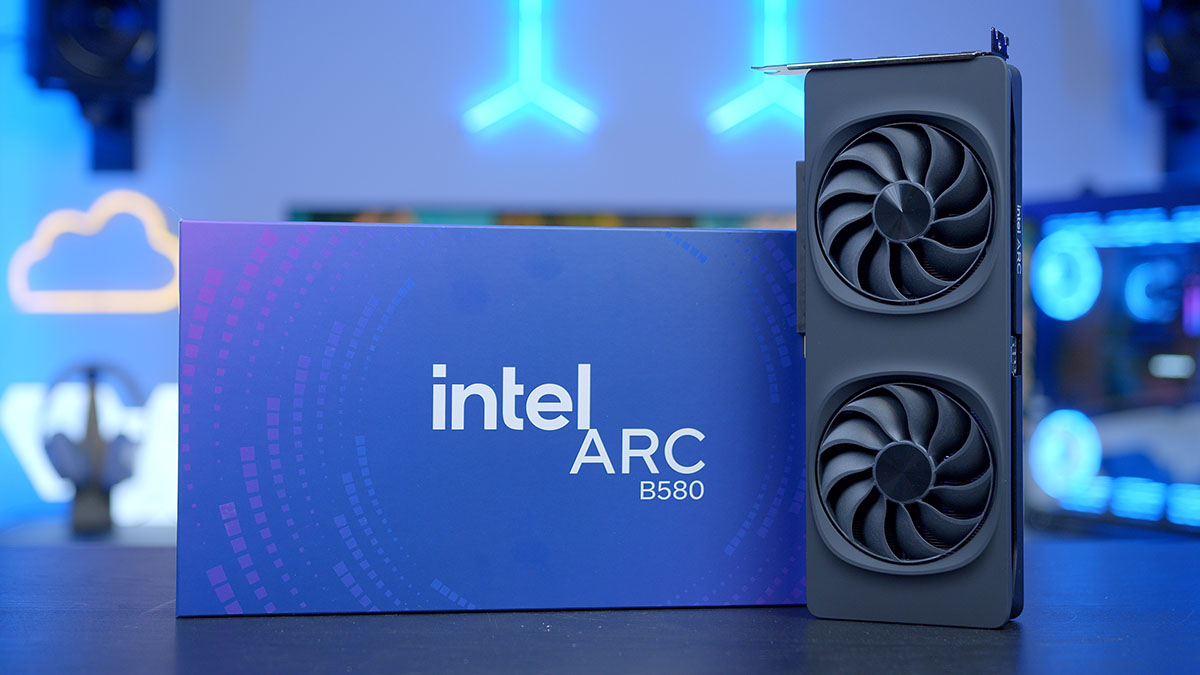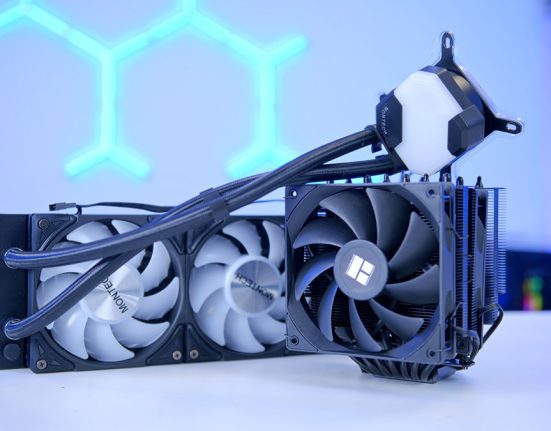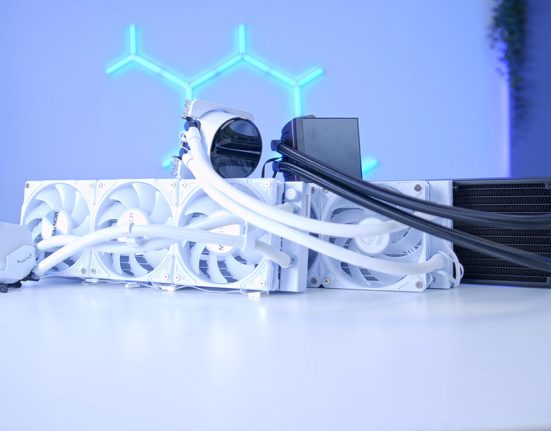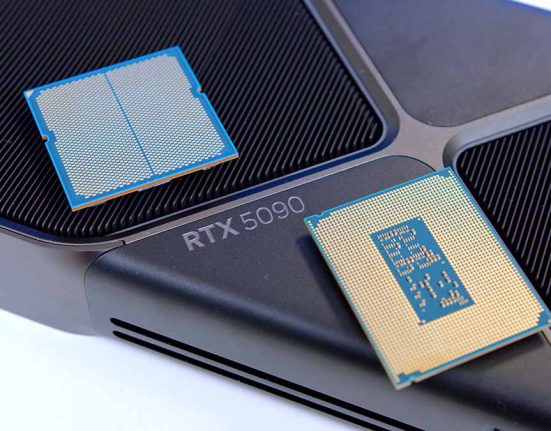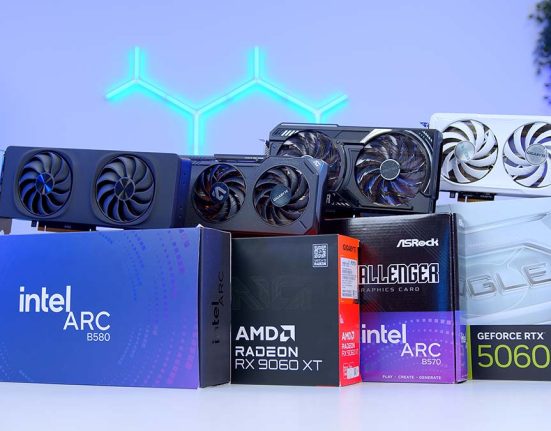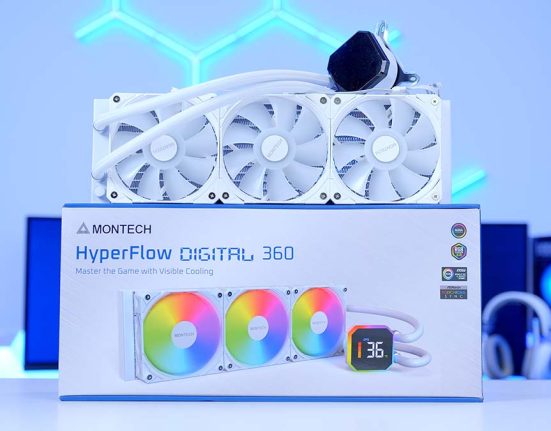Almost two years after their initial attempt at desktop GPUs, Intel is back, this time with the release of the first ‘Battlemage’ GPU, the Intel ARC B580. Set to build upon the foundations laid down by Intel Alchemist, the B580 comes loaded with healthy clock speed increases, better efficiency, and a brand-new architecture. Looking to shake up the lower-end market, the B580 launches at a competitive $249 MSRP, a move that Intel hope will land them as the new price-to-performance kings.
Having seemingly learned from their rivals’ mistakes, the Intel ARC B580 also comes with a healthy VRAM offering at launch—12GB, to be precise, and more importantly, 4GB more than both the RTX 4060 and RX 7600. With improved Upscaling and Raytracing performance also touted, Intel surely now has a GPU design capable of posing a serious threat to the longstanding AMD and NVIDIA duopoly. In this review, we’ll be evaluating if this really is the case by testing how the performance of this GPU stacks up against other options at similar price points.
Buy the Intel ARC B580 on:
Specification
The specifications make for interesting reading. At first glance, the B580 is a mixed bag: solid improvements coupled with unwanted restrictions. The healthy increase in VRAM up to 12GB is a welcome addition, but it is somewhat offset by the weaker memory bus compared to that of the previous generation, A580 and A750. Both Base and Boost Clock speeds have received healthy bumps up on the B580, and at a TBP of just 190W, it looks to be fairly power efficient too.

At face value, both core count and raytracing look to be weaker departments for the B580 compared to the previous ARC A-series GPUs. This, however, doesn’t account for the improvements Intel has made to the architecture. Now in its second iteration, Intel says the Xe2 architecture focuses on delivering higher utilization, less software overhead and improved workload distribution, all of which should, in theory, allow for the B580 to get higher performance per core.
| Key Specs | Intel ARC B580 | Intel ARC A580 | Intel ARC A750 |
|---|---|---|---|
| Video Memory | 12GB GDDR6 | 8GB GDDR6 | 8GB GDDR6 |
| Memory Bus | 192 bit | 256 bit | 256 bit |
| Base Clock Speed | 2670 MHz | 1700 MHz | 2050 MHz |
| Boost Clock Speed | 2850 MHz | 2000 MHz | 2400 MHz |
| Xe-cores | 20 | 24 | 28 |
| Render Slices | 5 | 6 | 7 |
| Ray Tracing Units | 20 | 24 | 28 |
| Power Consumption | 190W | 185W | 225W |
| MSRP | $249.99 | $179.99 | $249.99 |
Having redesigned their Xe cores to use Xe Vector engines for enhanced data efficiency, whilst also increasing the total shared cache by up to 33%, it becomes clear to see how Intel have improved performance on the B580 whilst seemingly lowering the specs at face value. Couple these changes with the introduction of XeSS 2 and Intel look to have solved the utlisation woes experienced on Alchemist GPUs.
Architecture
With the release of the B580, Intel has also rolled out their second-generation upscaling architecture, XeSS 2. Now, featuring Intel’s version of Frame Generation and a low latency mode, both aptly named XeSS-FG and XeSS-LL, respectively, the Intel package on offer with the release of the ARC B580 is much more substantial.
For those who are unaware, Frame Generation boosts performance by using AI networks. By taking two individual frames and pushing them through an AI network, Intel is able to create interpolated frames and slot this new frame in between the two original frames to improve not only performance but visual smoothness too. This can, at times, increase in-game latency or ‘lag’ whilst frames generate, hence the addition of XeSS-LL. By turning on both XeSS-FG and XeSS-LL, users should, in theory, be able to benefit from both the improved framerate performance of Frame Generation without experiencing the associated latency.

With Intel now having Frame Generation tech to challenge the likes of NVIDIA head-on, buying a budget GPU has become all the more exciting. Intel entering the GPU market and entering it well stands to act only as a great thing, in my opinion. Competition breeds innovation, forcing each brand to improve its offering in an attempt to get one over its rivals, and thus, in turn, improving their products to the benefit of the end users.
Design
Intel has followed a similar design philosophy when it comes to aesthetics, opting to refine the already existing design rather than starting from the ground up. The Intel ARC B580 Limited Edition looks strikingly similar to that of the past A-series Intel models. Sporting a black silicone-esque finish throughout, Intel has fully committed to the blacked-out theme, even removing the adjourning silver accenting previously seen across the length of their GPU design.
Intel has, however, decided to expose the heatsink atop the GPU, shortening the GPU backplate. Coupled with a dual-fan cooling solution seen on previous Intel designs, it will be interesting to see how the thermals compare. The change in the backplate has been made possible by the shortening of the GPU PCB itself, which allows for an extra exhaust vent in addition to the two already in place along each side of the GPU.

Elsewhere, the Intel ARC B580 now uses just one 8-pin PCIE power connector and has an added ‘Stiffening Ring’ around the circumference of each fan, which is said to increase rigidity while improving acoustics and performance. Aside from that, the Intel ARC B580 is much of the same, a very simple, sleek, blacked-out design, and whilst it won’t be for everyone, I am at least a fan of the performance-first approach, if a little too barebones for me at times.

Performance
The Intel ARC B580 was tested in gaming and synthetic applications to show how it copes in a standard gaming setting and more intense workstation-style loads. All the framerates in games and applications were recorded with CapFrameX where possible. Otherwise, data was taken from HWMonitor running in the background of each recording.
With the Intel ARC B580 priced at a very competitive price point in one of the most competitive market sectors, what better way to put it through its paces than to test it head-to-head against the direct competition? To do this, I put together a system featuring an X670E motherboard, 32GB 6000MT/s DRR5 RAM, 360mm CPU Cooler, a top-of-the-line Ryzen 7 9800X3D and choice of ARC B580, RTX 4060 or RX 7600 Graphics Cards. Each GPU was then tested in the same games at identical settings in identical environments (where possible) in an attempt to see just who reigns supreme as the best budget GPU.
Cyberpunk 2077
In Cyberpunk 2077, the ARC B580 got off to a flying start, topping the charts with over 100 FPS at 1080p High settings. Beating out the competition by nearly 20 FPS, in the case of the RX 7600, was not the start I, for one, expected. With the 12GB VRAM as standard, the B580 seemingly makes good use of this in Cyberpunk 2077, leaving the competition reeling in its dust.
However, there are some negatives to the performance of the B580 in this scenario, particularly when looking at the 1% and 0.2% lows. Whilst the B580 held a healthy lead in the Average FPS department, the percentage lows were a much tighter run race. With an average frame rate considerably higher than both the RTX 4060 and RX 7600, I’d (usually) expect the percentage lows to follow suit, as opposed to sitting, which is at times lower than the competition.

But what does this mean? For the ARC B580 to have percentage lows in the same region of the competition whilst averaging a higher frame rate means that the ARC B580 did experience more significant frame drops than either the RTX 4060 or RX 7600 did during our testing. Had the ARC B580 experienced frame drops of a similar size, then its average for the percentage lows would sit at a higher total. Whilst these are frame rate drops that happen only 1 or 0.2% of the time, they can significantly reduce perceived visual smoothness or make the game feel as though it’s stuttering.
At 1440p high settings, the ARC B580 once again beat out the RTX 4070 and RX 7600 by a healthy margin. More importantly, the B580 comfortably cleared the 60 FPS Mark, while both other options failed to do so. 1% lows looked much stronger for the ARC B580 here, too, and whilst the 0.2% lows are a little way off the capability of the RTX 4060, the B580 put in a strong performance once again.

Given the strong performance of the ARC B580 thus far and with Intel claiming significantly improved raytracing performance, I tweaked the settings of Cyberpunk 2077. Enabling raytracing at medium settings and with the upscaling equivalent for each card set to quality set about trying to dislodge the ARC B580 from its spot at the top. Needless to say, I couldn’t do it. The Intel ARC B580 held firm and retained its spot at the top of our Cyberpunk 2077 performance testing charts.
Knocking the RTX 4060 of its top spot in a raytracing scenario is no easy feat and is not to be understated. NVIDIA has long reigned supreme in the raytracing sector, and with AMD trying (and failing) repeatedly, it looked set to stay that way. Now, it is worth mentioning that this scenario was carried out without any Frame Generation equivalent technologies enabled, given the current lack of XeSS 2 support in many titles. It would be interesting to see just how the cards are stacked up here, but it can’t be overlooked how impressive it is for Intel to enter the game with strong raytracing performance, especially when looking at AMD’s woes in this area.

Alan Wake 2
Alan Wake 2, however, offered a complete role reversal. The Intel ARC B580 sits comfortably in last place in this title. Failing to to hit the 60 FPS mark at all at 1080p High settings is disappointing to see especially when the RX 7600 does so so comfortably. The story only worsens when glancing at the percentage lows, the ARC B580, again, in last place and this time by some margin. The RX 7600 and even the RTX 4060, with its tightly knit percentage lows, are much better options here.

Hogwarts Legacy
Hogwarts Legacy offers a chance for the ARC B580 to redeem itself slightly. This time, testing at 1440p High settings, the B580 sits in the middle of the pack, losing out by just 2 FPS on average to the RX 7600. The percentage lows for the B580 here are much better aligned with the competing RTX 4060 and RX 7600 too. Hogwarts, then too, is another title in which 1440p 60 FPS is a serious offering; dial this down to 1080p, and performance will only increase.

Apex Legends
Apex Legends, the fast-paced, first-person shooter and a title where every frame counts, proved a tough challenge for the B580. Whilst te B580 was able to surpass almost 200 FPS at 1080p High settings, it loses out to both the RTX 4060 and RX 7600 by some distance. Apex Legends is a title where I typically see AMD GPUs perform well during testing, making it no shock to see it top the chart here. The shock, however, comes in the fact that it beat the B580 by what is nearly 40 FPS on average.
This only worsens when we look at the percentage lows. The 0.2% lows of the RX 7600 thoroughly beat both the 0.2% and even the 1% lows of the B580, both times by at least 30 FPS. The RX 7600 and RTX 4060, to some degree, are the go to choices here at 1080p settings. However, there is some positive news for those looking to play at 1440p High settings…

During our in-house testing session, the ARC B580 leapfrogged its way from last to first place. The drop-off in performance when upping the resolution is much lower when it comes to the ARC B580 in Apex Legends. Now, whether this is because there is less performance at 1080p to drop off in the first place, I’ll leave it up to you. Nevertheless, the ARC B580 pulled in a solid average of 167.8 FPS, a figure that will be particularly of interest to those looking to play at 144Hz.
The ARC B580, comes as a surprise package at 1440p High settings. Quite comfortable sitting and gaming at 1440p, even more so than 1080p at times. While Intel haven’t quite mastered it yet, with performance lows fluctuating significantly, for those looking solely at the total FPS average, the B580 is a serious potential pick up choice.

Fortnite
Fortnite placed the B580 firmly in last place and almost 100 FPS off of top spot. With the RTX 4060 pulling in a high FPS average of 345 frames and the RX 7600 also clearing 300 FPS, there is clear daylight between these GPUs and the B580. But. The ARC B580 clears 260 FPS on average, a number that is by no means small, and unless you’re planning on playing at 360Hz, 262 FPS on average should be more than enough and sits well clear of 240 FPS for those with a 240Hz capable monitor.

Conclusion
Intel ARC B580
Product Name: ARC B580
Brand: Intel
-
Features
-
Design
-
Performance
-
Value for Money
Summary
So, where does that leave us? Intel has done a commendable job of bringing a 1440p cable GPU (at times) to the market at a competitive price point. The ARC B580 is a definitive improvement over their first attempt with A-series GPUs and has carved out a serious position for Intel in the GPU conversation but maybe not the market just yet.
Intel has seriously improved its value offering, particularly with strong raytracing performance, but I can’t help but feel that they’ve got it wrong. Not wrong in the sense of having not improved their architecture enough or wrong in the sense of a having weak pricing structure but wrong in the sense that they’ve targeted the wrong audience with this GPU. I personally, would hazard a guess that people looking to buy this GPU are not too fussed with raytracing performance or even 1440p in some cases and by no means am I saying that it is a bad thing that this GPU is capable of doing both of these things pretty comfortably. What I am saying, however is, and I am happy to be wrong that a budget $250 GPUs target audience has been and is still currently those looking to play at 1080p rasterised settings and get as many frames as possible. As we saw in Esports titles like Fortnite and Apex Legends and even single-player titles like Alan Wake 2 too, the ARC B580 is still a way off at times in this sense versus the competition, even more so when accounting for frame drops.
I have mixed feelings about this GPU, I really do. I want nothing more than for it to succeed and for Intel to become another serious GPU option but I do worry for the future of this card. Intel have chosen to launch this GPU at an interesting time, at the end of the generational life cycle for both AMD and GPUs offerings. Against the backdrop of potential new GPU generation offerings from AMD and NVIDIA in the new year, I can’t help but feel that the ARC B580 may become outdated before it’s even had a chance and for that reason I personally wouldn’t recommend it.
Let’s get one thing clear though, Intel have done a great job of improving upon their initial entries to the GPU market. The B-series GPUs stand to be much more competitive, even if only for a number of months, and as I said earlier, competition breeds innovation. Intel’s impressive foray into raytracing may give the likes of AMD and NVIDIA the nudge to improve their next generation that bit further as a result of the ARC B580 if nothing else.
Pros
✅ Improved architectural tech
✅ Competitive Price
✅ Raytracing performance
Cons
❌ Weak percentage lows
❌ Barebones design
❌ Cooling solution


